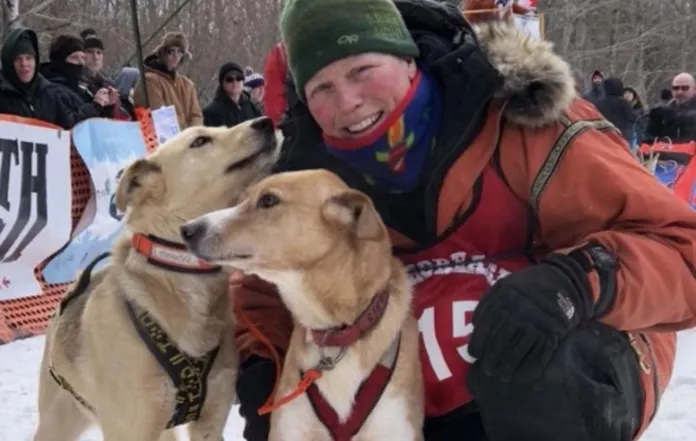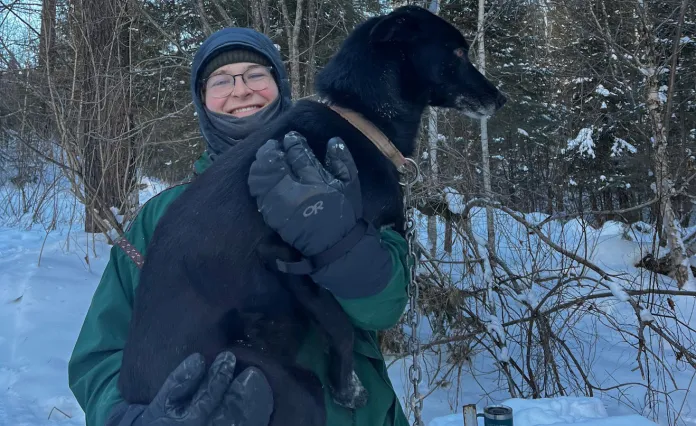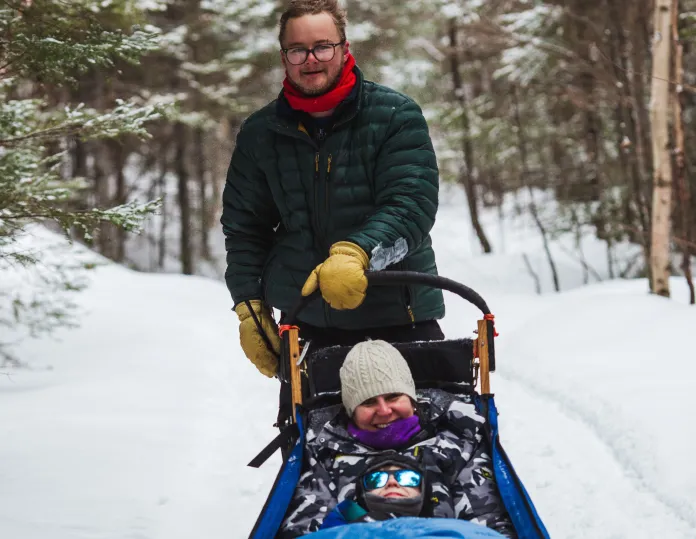Exploring the Thrill of Winter’s Oldest Adventure
Dog Sledding at Menogyn
As featured in Letters from Camp Magazine – Fall 2025.
Walking out of the dining hall, the chorus of 21 excited Alaskan huskies barking, jumping, twirling, and vying for attention is loud. They are a variety of colors, and each has a unique personality. Some are eager to greet visitors and yelp for attention. Some are shy and stay inside their individual dog houses.
This is the dog yard at YMCA Camp Menogyn.
Assuming that winter has provided us with a good coating of snow on the ground, seasonal Menogyn visitors are invited into this daily experience, with the opportunity to meet the dogs and learn about the ancient sport of dogsledding.
A marvel of Menogyn’s fall, winter, and spring program options, it is just one of many adventures most Y campers have yet to experience.
As the day’s activities begin, campers will see a special scene unfold as the dogs prepare to be harnessed and connected to the sleds that they will pull during the dogsled ride. There is an overwhelming amount of energy and excitement emanating from the crowd of dogs. Only six will be chosen to pull one sled, and all of them are eager to run!
Once all the dogs are connected to the sled, the rider (this could be you, Menogyn campers!) snuggles into blankets inside the cordura (similar to canvas) sled, while the musher is on the back of the sled to yell commands to the dogs. Sleds are wood, high-tech plastic, with lightweight aluminum runners and metal brakes, which allow for a comfortable and safe ride for the humans and dogs.
Before the ride, it is a cacophony of noise and excitement, but the actual sled ride is almost silent. The canvas sled drags across the snow, making a light whooshing sound. The dogs no longer bark but are focused on pulling. They work as a team with the lead dog guiding the way. They move quickly along the snowy paths, happy to be running outside in the brisk air.
The experience is visceral, raw, and intensely beautiful.

Alaska – Northern Minnesota; Tomato – Tomahto
Dogsledding at Camp Menogyn originated in the 1980s as a “great partnership between two organizations,” shared Rolf Thompson, director of Menogyn from 1983-89, who was friends with the director of Wilderness Inquiry, an organization that offers wilderness experiences to people with disabilities.
“Dogsledding was a way to help more people experience the beauty of the North woods in winter, and with Menogyn’s staff, kitchen, and dining hall, it provided an ideal setting to host the program. The program began as a weekend or two, and over the years, it grew into what it is today, a rare opportunity that families seek out as a winter exhibition.
Currently, the program includes two staff members (the mushers) who manage over 20 dogs that live onsite at camp from December through March. Dogsledding takes place during winter family camps, outdoor education programs, and community programs that run throughout the winter season. Visitors are encouraged to visit the dog yard and interact with the dogs throughout the few months they are on site. The mushers run the dogs every day and give sled rides whenever possible. They also give “dog talks” where they share details about caring for dogs, provide insight into the history of dog sledding, and answer questions about anything dog sled related.
The Four-Legged Dream Team
Mary Manning is known as the “chief dog wrangler” and owns Doodledog Kennel in Hovland, Minn. with her wife Julie. She owns 50 dogs that she trains, cares for, and runs in sled dog races. From October to December, the Menogyn mushers live, work, and train with Mary before the dogs head to Menogyn for the winter program season.
Mary has been competing in dogsled racing on and off since 1997. She “loves the controlled chaos while the dogs are getting ready to go, followed by the peaceful quiet on the trail. It brings joy and peace when things seem so chaotic in the world — to be present in that moment with the dogs.”
When asked what people should know about sled dogs, she shared, “These dogs have been bred to run and pull, and that’s what they love. You can’t force a dog to pull. Each dog has a unique personality. Some like to run short distances and are done. Some like to go for long runs. Some are good leaders. You have to get to know the dogs to get them to work as a team.”
Mary loves to see how much the dogs enjoy what they do and hopes that “people can feel all the love and joy reflected back to them, and that they make a connection with the dogs.”

What it Takes to “Mush”
Ryan Odermatt held the title of Menogyn Musher in 2024-25 (in addition to being a trail guide during the summer). “Mary’s place is unique,” he shared, “because it’s off the grid, with no cell service, and located way out there. Her systems are dialed in and really set up for the dogs. Her and Julia are so welcoming, so kind.”
Ryan described his three months of training with Mary as “a good combination of Mary taking time to show you what you need to do, but also giving space for me to figure out what works because mushing is unpredictable and so you need to be able to problem solve.”
“At the end of 10 weeks, I felt nervous, but also confident. Well prepared. Something Mary and other mushers had stressed repeatedly is that the dogs rely on you for everything. Rely on you to survive. With Mary, we helped, but we weren’t the sole caregivers. At Menogyn, we were the ones with the most training and experience, and it was our responsibility to care for them. It’s a big responsibility to provide the highest level of care.”
Ryan went on to detail his life as a musher:
“My day and whole life revolved around dogs. They were my first and last thoughts of each day. Dog sledding is a partnership between humans and dogs. If you see a musher with well-fed, well-trained, happy dogs who are happy to run, you have a musher who has dedicated their life and energy to taking care of dogs. You will never find better cared for dogs than these. These are working animals who love what they do. But if you don’t let them use their bodies, they won’t be as happy. They need enrichment and the opportunity to run. If they aren’t running, they get moody and misbehave.”
Mary echoed Ryan’s comments, saying, “I’m happy they have the opportunity to get out there and run.”
One of Ryan’s favorite memories was during a program that Wilderness Inquiry brought to camp. “Mark, who used a wheelchair, came to the dog yard. Roscoe was one of the big male dogs who was silly and really sweet. He crawled into Mark’s lap and rested his head on Mark’s chest. I think he could sense that he needed to go to Mark to have that connection. He was so gentle and respectful. Dogs are really socially aware.
Ryan’s favorite thing as a musher was seeing people get excited to meet the dogs and shared how he found it “really special to provide this experience to people.”

Adventure is Year-Round
When asked about this special programming, Menogyn Executive Director Forrest Ahrens said, “The dogsledding program is unique to Menogyn’s winter programming and something we are really proud of. We love our dogs up here, and it’s really a magical thing to see kids’ faces light up as they connect with the dogs. I think that dogsledding is a way for people to engage with the history of this area and some of the culture that people are not as familiar with. The word ‘camp’ often makes people think of summer, but there is a whole world of adventure waiting for you in the other months of the year, too.”
Mary fittingly added, “If you have the opportunity to take the adventure, do it. Maybe you’ll never do it again, but maybe it will change your life.”
Learn more about winter programming at Menogyn and to sign up for your own Menogyn adventure.